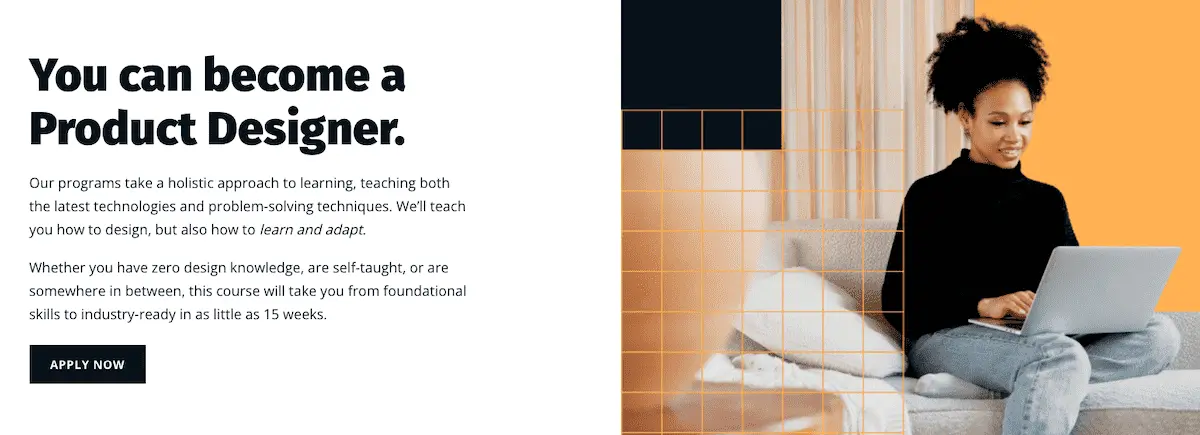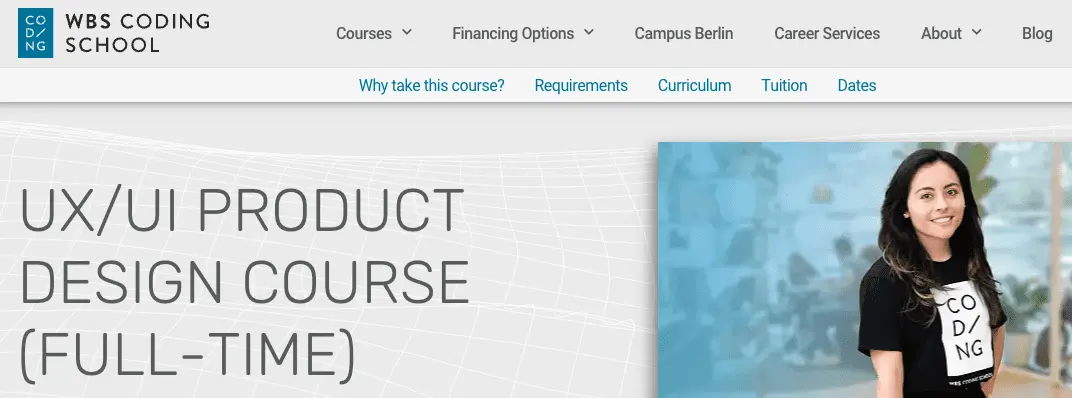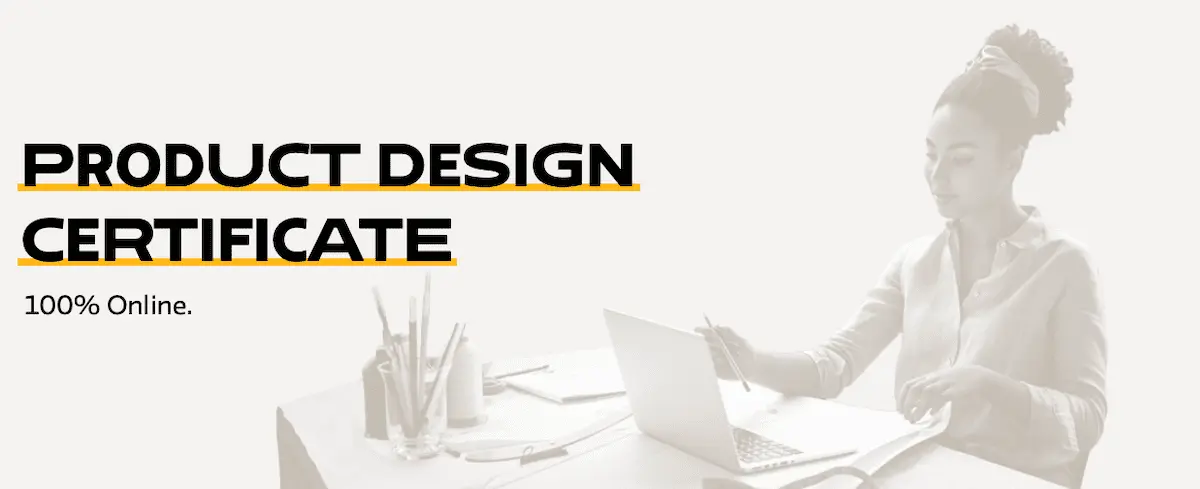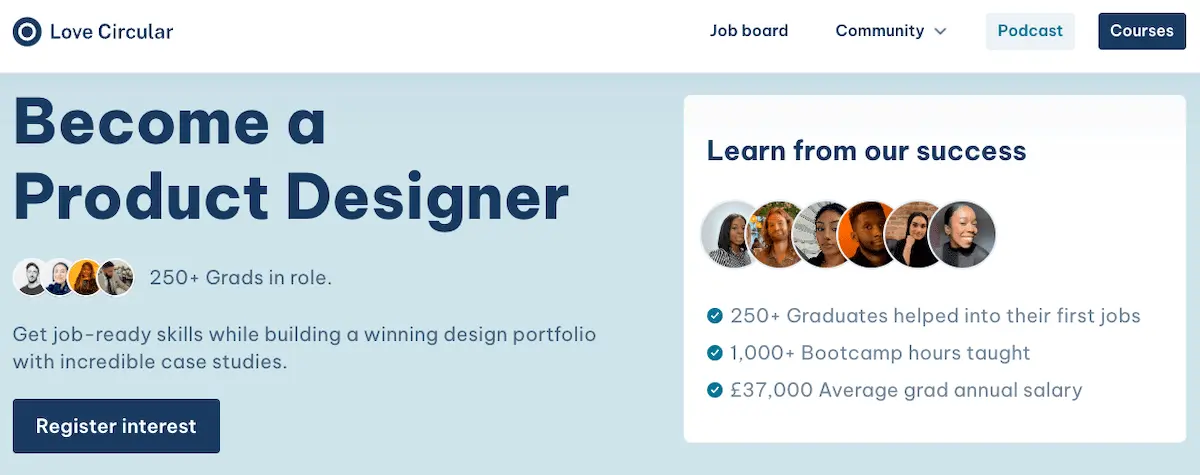Are you ready to launch your product design career? Now’s the time to consider a product design bootcamp.
Product design bootcamps offer rigorous, up-to-date training with a focus on job skills.
They’re practical, flexible, and typically less expensive than traditional college degrees—a great option if you want to kick-start your product design career without going back to school.
But which product design bootcamps are actually worth the money?
We compared the most popular options on the market to come up with a definitive 2025 shortlist.
Here’s what we’ll cover:
- 13 of the best product design bootcamps to consider in 2025
- How are product design bootcamps different from UX/UI design bootcamps?
- Wrap-up and next steps
- Additional resources for aspiring product designers
- Product design bootcamps FAQ
So let’s compare the best product design bootcamps on the market right now.
13 of the best product design bootcamps to consider in 2025
1. CareerFoundry Product Design Bootcamp

At a glance:
- Format: Online, flexibly paced
- Duration: 5 months full-time (30-40 hours per week) or 10 months part-time (15-20 hours per week)
- Price: $7,505 upfront or $7,900 in monthly installments
You don’t need a degree to become a qualified product designer—nor do you need experience in a specific field. What you do need is practical, skills-based training, expert instruction, one-to-one mentorship, and the opportunity to build out your product design portfolio.
And that’s exactly what you get with CareerFoundry’s Product Design Program. You’ll study flexibly online to develop your practical skill set, covering everything from the user-centered design process and design thinking through to user research, prototyping, UI fundamentals, usability testing, and design handoff.
At the end of the bootcamp, you’ll work with a dedicated career coach to polish up your product design resumé and apply for relevant jobs. If you don’t get a job within six months of graduating, you may be eligible for a full refund.
The CareerFoundry bootcamp offers excellent value for money, providing a flexible yet thorough career-change package—teaching you everything you need to get hired as a product designer.
Learn more: The CareerFoundry Product Design Program
2. Flatiron School UX/UI Product Design Bootcamp

At a glance:
- Format: The full-time bootcamp is available in-person or online; the part-time bootcamp takes place online
- Duration: 15 weeks full-time or 40 weeks part-time
- Price: $16,900
If you’re looking for a thorough and immersive (albeit expensive) product design education, consider Flatiron School’s UX/UI Product Design Bootcamp.
With the full-time option, you’ll study product design intensively for 15 weeks with a rigorous schedule of 8 hours per day, Monday to Friday. Lessons take place synchronously—meaning you’ll need to be present either online or in-person for the duration.
If you’re not able to study full-time, the part-time schedule offers more flexibility. Over the course of 40 weeks, you’ll study asynchronously at your own pace with pre-recorded lessons and optional live lectures.
Whether you opt for the full or part-time schedule, the Flatiron School UX/UI Product Design Bootcamp promises a holistic learning experience. You’ll master emerging technologies and problem-solving techniques, and build a professional product design portfolio.
Learn more: Flatiron School Product Design Bootcamp
3. WBS Coding School UX/UI Product Design Course

At a glance:
- Format: Hybrid (13 weeks online and 2 weeks on campus) or fully online
- Duration: 15 weeks
- Price: €10,500 euros ($11,483) for the hybrid bootcamp; €9,900 ($10,827) for the fully online option
The UX/UI Product Design Course offered by WBS Coding School requires 15 weeks of full-time study, Monday to Friday from 9am to 6pm. Students can choose between the fully online bootcamp or a hybrid approach. The latter comprises 13 weeks online and 2 weeks on campus in Berlin, Germany.
The bootcamp is divided into five core modules: UX research, ideation and UI design, product management, service and strategy design, and portfolio and teamwork. You’ll learn through interactive seminars, practical projects, and virtual networking.
Consider this an immersive and interactive foray into product design, with the added bonus of career support. A great option for those who can commit to full-time study.
Learn more: WBS Coding School’s Product Design Bootcamp
4. The New School Product Design Certificate

At a glance:
- Format: Online
- Duration: 9 weeks
- Price: $2,805
Many product design bootcamps are geared towards beginners and career-changers. But what if you’ve already got some design knowledge and want to level up your skills? Then this one’s for you!
The New School Product Design Certificate is a nine week bootcamp that teaches a practical framework for designing, prototyping, and launching new product ideas—with particular emphasis on sustainable physical products.
The curriculum comprises three distinct courses: Product Design Foundations, How to Prototype a New Product Idea, and How to Launch a New Product Idea.
Within those courses, you’ll delve into specialized topics such as sustainable materials and manufacturing methods, 3D printing, demonstrations of basic CAD (Computer-Aided Design) software, and product packaging and shipping.
Note that the curriculum has been designed for entrepreneurs, designers, and those working in the manufacturing field. If you’re looking for a beginner-friendly bootcamp, you’ll want to explore other options on our list.
Learn more: The New School Product Design Certificate
5. Love Circular Product Design Bootcamp

At a glance:
- Format: Online via Zoom
- Duration: 12 weeks
- Price: $2,599
Love Circular is a London-based provider offering career-change courses for beginners. Their Product Design Bootcamp spans 12 weeks, with lessons taking place twice per week via Zoom.
Students benefit from live, expert instruction—and, because the classes are capped at 12 people, there’s plenty of opportunity to ask questions and get detailed feedback.
The curriculum covers UX methodologies, UI design, accessibility, case studies, and a dedicated careers module. Note that we couldn’t find any mention of practical project work, so you may not graduate with a product design portfolio. Still, this is a bootcamp worth considering if you’re looking for a more affordable introduction to product design.
Learn more: Love Circular Product Design Bootcamp
6. The Design Crew Product Design Bootcamp
At a glance:
- Format: In-person in Paris, France
- Duration: 8 weeks
- Price: €7,990 ($8,714)
If you’re based in Europe or willing to travel, consider an 8-week product design bootcamp in Paris. Led by The Design Crew, this full-time bootcamp offers one of the most immersive, hands-on training options we’ve seen on the market so far.
Throughout the course, you’ll work on three real projects set by partner companies—giving you first-hand insight into what it’s like to work as a product designer and solve complex design challenges on a daily basis.
In doing so, you’ll learn the product design process from end to end, covering everything from ideation and problem definition through to user testing and presenting your work. You’ll even learn about UX writing!
This bootcamp requires full-time, in-person attendance, so it won’t be doable for everyone. But, if you’re able to spare the time, this is an excellent way to kick-start your career in product design.
Learn more: The Design Crew Bootcamp: Become a Product Designer
7. Accelerate Your Product Design Career with Jacalin Ding
At a glance:
- Format: Online, live sessions
- Duration: 4 weeks (3-4 hours per week)
- Price: $895
Product design bootcamps aren’t just for newbies. If you’re a junior or mid-weight designer looking to take the next step in your career, consider Jacalin Ding’s online product design bootcamp.
Throughout the 4-week course, Jacalin promises to help you transform into a strategic and influential designer. You’ll learn how to “stop being a feature design machine” and “start impacting businesses with design.”
This expert-led bootcamp equips you with skills, strategies, and frameworks to influence the design culture in your company, become a more business-savvy designer, effectively win stakeholder buy-in, and measure and evaluate the impact of your work. Extremely important skills if you want to progress in your career!
Learn more: Accelerate Your Product Design Career with Jacalin Ding
8. Pratt Institute Digital Product Design Bootcamp
At a glance:
- Format: Interactive classes and real-time instruction (available in-person or on Zoom)
- Duration: Not specified
- Price: $3,500
Product design is a collaborative career path, so why not take a collaborative approach to learning?
With the Pratt Institute’s digital product design bootcamp, you’ll learn through small interactive classes and real-time lessons—led by product design experts either in-person or on Zoom. You’ll also have access to designated campus labs in New York.
While product design applies to both physical and digital products, this particular bootcamp focuses on web and mobile apps. You’ll learn the end to end digital product design process, starting with a creative brief and a user persona to inform your work.
From there, you’ll create user flows and wireframes, apply visual design concepts, learn how to use a design system, and conduct usability tests.
Everything you do throughout the bootcamp will culminate in a portfolio-ready case study. Upon successful completion, you’ll receive a professional product design certificate.
Learn more: Pratt Continuing and Professional Studies—Digital Product Design
9. MIT xPRO: Designing and Building AI Products and Services
At a glance:
- Format: Online
- Duration: 8 weeks (6 hours per week)
- Price: $2,950
Our final product design bootcamp is for experienced designers, product managers, and consultants who want to enhance their understanding of AI technology and tools, and learn about the process for designing AI-based products.
Over the course of eight weeks, you’ll explore the four stages of AI product design, analyze the technical and operational requirements to build AI models, learn how to design AI products to solve organizational issues, and learn to apply machine learning methods to practical problems.
It’s an intense and complex curriculum, requiring a solid foundation of existing technical knowledge. But, if you’re ready to be at the cutting edge of product design for AI, this is an exciting and highly valuable product design bootcamp.
Learn more: MIT xPRO Designing and Building AI Products and Services
10. MIT Sloan Executive Education: Mastering Design Thinking
At a glance:
- Format: Online video lectures and live teaching sessions
- Duration: 3 months, 6-8 hours per week
- Price: $2,937
Although it’s not a product design bootcamp per se, MIT Sloan’s 3-month certificate program covers an essential topic that all product designers should master: design thinking.
The Mastering Design Thinking course will empower you to leverage the potential of design thinking, “with a focus on applied creativity to craft innovative solutions for improving an existing product or setting up a new product.”
If you’ve already got some product experience, this bootcamp will help you take your innovation skills to the next level. After 140 video lectures, three live teaching sessions, three group projects, ten assignments, and a capstone project (whew!), you’ll be well-equipped to understand your customers’ needs, prototype innovative solutions, and select a suitable product development process for any project.
Learn more: Mastering Design Thinking by MIT Sloan Executive Education
11. Experience Haus Product Design Bootcamp (including UX and UI)
At a glance:
- Format: In-person (London, UK)
- Duration: 12 weeks part-time
- Price: £1,950 ($2,457)
If you’re based in London (or have the opportunity to travel there), you can train at a leading design agency with Experience Haus’ product design bootcamp.
Over the course of twelve weeks, you’ll cover the end-to-end product design process—from design thinking and user research through to business viability, competitor analysis, UX and UI design, and much more.
Experience Haus students learn through collaborative classes and workshops in small groups of eight. You’ll also apply your learnings to a real-life design challenge set by a local business. You can expect a hands-on curriculum and a steep learning curve with this product design bootcamp! Ideal if you want job-ready skills that will allow you to hit the ground running.
Learn more: Experience Haus Product Design Bootcamp (inc. UX and UI)
12. The Craft Professional Product Design Bootcamp
At a glance:
- Format: Online, self-paced
- Duration: 4-6 months (around 20 hours per week)
- Price: $8,800
For beginners aspiring to break into the design industry, The Craft promises a comprehensive product design bootcamp that teaches future job skills.
The bootcamp is completely self-paced—but bear in mind that the course providers recommend 20 hours of study per week in order to make meaningful progress. At that pace, you can expect to complete the bootcamp within four to six months.
Through videos, quizzes, and other proprietary content, you’ll learn about different roles in the tech industry, the most important product design tools, and the processes designers use to solve end-user problems.
And perhaps most exciting of all: you’ll also complete an internship with one of The Craft’s partner startups. If you’re ready for an intensive product design education and are able to put in the hours each week, consider adding this bootcamp to your shortlist.
Learn more: The Craft Professional Product Design Bootcamp
13. Chigisoft Product Design Bootcamp (Online)
At a glance:
- Format: Online
- Duration: 12 weeks (8 weeks of learning, 4 weeks of industry experience)
- Price: $500
The final product design bootcamp on our list is also one of the most affordable—a great option for those seeking product design training at a lower price point.
Made for beginners, the Chigisoft Product Design Bootcamp comprises eight weeks of hands-on learning followed by four weeks of real-world practice. For the first part of the bootcamp, you’ll attend live online sessions on Mondays, Wednesdays, and Fridays (starting at 8pm WAT / 2pm EST). For the remaining four weeks, you’ll work on a design problem for a real product company from Chigisoft’s partner network.
If you want the structure of live classes with the flexibility of remote learning, the Chigisoft Product Design Bootcamp offers a good mixture of both.
Learn more: Chigisoft Product Design Bootcamp
How are product design bootcamps different from UX/UI design bootcamps?
Product design, UX design, and UI design are closely connected—and the terms are often used interchangeably. But, technically speaking, they’re not the same thing.
Product designers are like full-stack designers. They take a holistic view of the product, considering the end-user’s needs, the business goals, and the competitive landscape. UX and UI designers, on the other hand, focus primarily on the interaction between the end-user and the product.
UX designers map out the structure of the product so that it’s logical and intuitive for the user. They ensure that the product is functional, accessible, user-friendly, and enjoyable overall.
UI designers consider how digital product interfaces look, feel, and function. They focus specifically on the point of interaction between the user and the system, designing all the screens and pages a user encounters when they navigate an app or a website. This includes the layout, color, typography, and icons for each screen, as well as the interactive responses that are triggered when a user takes certain actions (for example, clicking a button).
They’re all equally important for creating successful products—but they approach the task from different angles. As such, they each require unique skills, techniques, and tools.
That’s where product design, UX design, and UI design bootcamps differ.
Product design bootcamps should cover everything you need to execute the product design process—including market research, competitive analysis, understanding business requirements, and design documentation (to name just a few). You should also expect to cover UX and UI design as part of your product design bootcamp.
UX and UI design bootcamps, on the other hand, will zoom in on these specific aspects of product design. You can expect the course content to focus more heavily on user empathy, usability, interactivity, and visual design.
Should you do a product design bootcamp or a UX/UI design bootcamp?
That depends on your career goals and what exactly you want to learn. The best bootcamps include practical projects and portfolio-building, and you want to ensure that your portfolio matches up to what hiring managers are looking for.
So, if you want to become a UX designer and apply for UX-related roles, your best bet is to take a UX design bootcamp. We’ve rounded up the most reputable UX design bootcamps in this guide.
If your interests lie in visual and interactive design for digital products, focus your training on user interface (UI) design. A high quality UI bootcamp will teach you everything you need to know about designing pixel-perfect apps and websites. Here’s a round-up of the best UI design bootcamps worth considering.
If you see yourself in a full-stack role spanning UX and UI design, market research, and business strategy, you’re on the right track with product design. A good product design bootcamp will equip you with all the theory, tools, and practical skills you need to excel in the field.
Wrap-up and next steps
You’re now familiar with some of the best product design bootcamps on the market. So what next?
First, create a shortlist. Consider your budget, your schedule, and how you want to learn—as well as your learning goals. This will enable you to eliminate certain bootcamps right off the bat and narrow it down to a few frontrunners.
Next, do more research. A product design bootcamp requires significant financial investment—not to mention your time and dedication. Don’t sign up before you’ve done your due diligence. Speak with program advisors to learn more about what’s on offer, read alumni stories, and double and triple check that you’re getting the best value for money.
Finally, make the most of your product design bootcamp. Once you’ve chosen a bootcamp and signed up, set yourself up for success. Figure out when, where, and how often you’ll study (this is especially important if the course is flexible or self-paced), and make sure you’ve got all the materials you need.
And one more thing: don’t limit yourself to what’s on the course curriculum. Supplement your product design bootcamp with books, podcasts, videos, and blog posts. At the same time, connect with fellow learners and aspiring product designers. It’s never too early to start networking—and perhaps your bootcamp already has a thriving community you can join.
Additional resources for aspiring product designers
Excited to start your product design career? You should be! It’s a varied and creative field where you can really make an impact. And, as the industry continues to grow and evolve, there’s never been a better time to learn in-demand product design skills and enter this burgeoning job market.
If you’d like to learn more about what it takes to succeed as a product designer, check out these additional resources:
Product design bootcamps FAQ
Still got questions about product design bootcamps? Let’s go through some of the most popular ones:
Are product design bootcamps worth it?
Yes! If you want to learn job-ready skills and prepare for a career in the industry, a product design bootcamp provides thorough and practical training—without the hefty price tag of a college degree. You’ll also benefit from expert instruction, mentorship, and career support.
Is product design the same as UI/UX?
No. Product design, UX design, and UI design are interrelated but they’re not the same thing. Product design takes a holistic approach, considering the end user, the competitive landscape, and the overarching business strategy. UX design focuses on the interaction between the user and the product, while UI design focuses on how the product interface looks and functions.
What pays more, UX or product design?
Salary figures vary depending on industry, company type, location, and years of experience. The average salary for a UX designer in the United States is $104,596 (Indeed). The average salary for a product designer in the United States is $120,998 (Indeed). For a more in-depth exploration, refer to our UX designer salary guide and our product designer salary guide.
Does product design require coding?
No, product designers are not required to code. However, some fundamental coding skills can come in useful. Product designers need to understand the technical constraints surrounding the product and collaborate closely with developers. Knowledge of coding can help with those aspects of the role, and many product design bootcamps will teach HTML basics.
